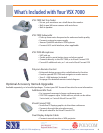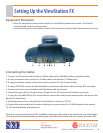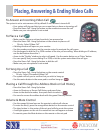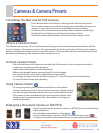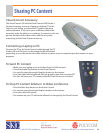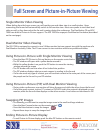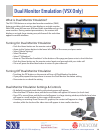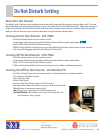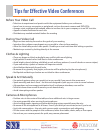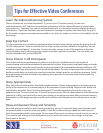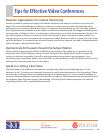
SERMC Contact: Tad Hunt (402) 219-7378 thunt@stez.org SKC Contact: (800) 882-7779 contact.us@skccom.com 17
Tips for Effective Video Conferences
Learn the Videoconferencing System
There’s no reason for you to feel intimidated - if you can use a TV remote control, you can use a
videoconferencing unit! Take time to experiment and practice with the videoconferencing system before
your conference - especially if you plan to use peripherals such as a document camera, computer hookup, or
other devices. If you have associates who are interested in learning the system, solicit their help. The goal is
for the system to appear as transparent as possible so you and your audience can focus on the subject, not the
technology.
Keep Eye Contact
To help remote learners (associates) participate and feel included, relate directly to them by looking directly
into the video camera. If you do not look into the video camera, associates will feel as though they are just
watching - not participating - in the class. Envision the video camera as one of the associates in the class.
During meetings, don’t turn away from the camera and begin a private conversation. This can make your
remote participants feel just that: REMOTE!
Show Interest in All Participants
Since videoconferencing participants are spread across distances, facilitators must make a point of
communicating with remote partcipants by name and/or location. Keep a pencil and paper handy and make
a “participant map” using the names/location of your participants. Most people feel awkward talking to a TV
monitor and will lapse into passivity if not specifically addressed. Two-way compressed video systems usually
exhibit an audio delay, so double your usual wait time after asking a question or soliciting comments. Lastly,
bring particpants into each interaction by repeating every question or comment made, ensuring that the
other sites can hear.
Dress Appropriately
Wear solid-colored clothing rather than bold, complex patterns. Stripes or busy patterns can destroy picture
clarity as the camera tries to constantly adjust to the movement of your clothing. Bright red can “bleed” and
video quality may suffer. Take a hint from professional TV and photography and notice the colors and
patterns worn by TV news announcers. If you will be signing as part of your videoconference with the hearing
impaired, it is likely your hands will be using your clothing as a background, which adds yet another element.
Remembebr too that dangly earrings, bracelets, and necklaces can be heard over the microphone or can add
glare.
Move and Gesture Slowly and Smoothly
Move and gesture normally, but avoid swaying, rocking, or pacing. Compressed video cannot transmit rapid
movements without some loss of picture quality. If you like to walk around, go ahead, but make sure you
know the parameters of the camera range. You can tape off your spot so you know exactly how far you can go.
If you tend to walk with your hands flying about, you can zoom the camera in close enough so that your
hands aren’t in the shot.




